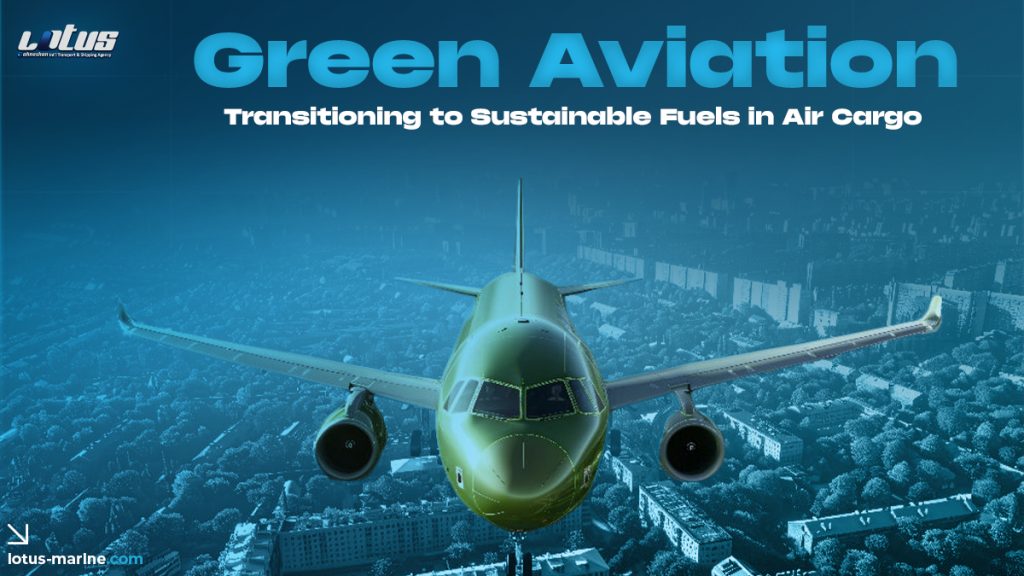Introduction
The aviation industry, including air cargo, is under increasing pressure to reduce its environmental impact. Green aviation, driven by the transition to Sustainable Aviation Fuels (SAF), presents an opportunity to balance operational efficiency with eco-friendly practices.
What is Green Aviation?
Green aviation refers to adopting sustainable practices and technologies to minimize the environmental impact of air travel and cargo. This involves fuel efficiency, emission reduction, and the use of SAF to achieve cleaner operations.
The Environmental Impact of Air Cargo
Air cargo is vital for global logistics, but it is also one of the most carbon-intensive transport methods.
- Carbon Emissions: Aviation contributes about 2.5% of global CO2 emissions.
- Pollution: Jet fuel combustion releases nitrogen oxides, contrails, and particulates, affecting air quality and climate.
The industry’s heavy reliance on fossil fuels demands urgent action to embrace sustainable alternatives.
Why Transition to Sustainable Fuels?
- Urgent Need for Sustainability: Global climate goals, such as net-zero emissions by 2050, require significant changes in air cargo fuel consumption.
- Environmental and Operational Benefits:
- Reduction in greenhouse gas emissions.
- Compliance with stricter environmental regulations.
- Cost efficiency over the long term.
Types of Sustainable Aviation Fuels (SAF)
- Biofuels: Derived from renewable biomass sources such as crops, algae, and waste oils.
- Synthetic Fuels: Produced using renewable energy and carbon captured from the air.
- Hydrogen-Based Fuels: Combustion of green hydrogen produces water vapor instead of CO2.
How are SAFs Produced?
Sustainable aviation fuels rely on clean feedstocks and advanced technologies for production:
- Feedstocks: Waste oils, agricultural residues, municipal waste.
- Processes:
- Hydrotreated Esters and Fatty Acids (HEFA).
- Fischer-Tropsch synthesis.
Advantages of SAF in Air Cargo Operations
- Lower Carbon Footprint: SAF reduces up to 80% of lifecycle carbon emissions compared to conventional jet fuels.
- Improved Fuel Efficiency: SAF blends provide better combustion efficiency.
- Cost Benefits: While initial adoption is costly, fuel prices are expected to stabilize as production scales up.
Challenges in Implementing Sustainable Aviation Fuels
- High Production Costs: SAF production remains more expensive than conventional fuels.
- Limited Infrastructure: Airports and airlines need significant upgrades to handle SAF.
- Regulatory and Supply Barriers: Limited availability hinders widespread adoption.
Global Efforts and Initiatives for SAF Adoption
- IATA Initiatives: The International Air Transport Association promotes SAF as a critical element of carbon-neutral growth.
- Government Policies: Countries like the USA, UK, and Japan offer incentives for SAF production.
- Corporate Efforts: Airlines and logistics companies are investing in sustainable solutions.
Innovative Technologies Supporting Green Aviation
- Hybrid Aircraft: Combining traditional and electric power to optimize fuel use.
- Electric Cargo Drones: Small electric drones for last-mile delivery reduce emissions.
- AI and IoT: Advanced tools to optimize fuel consumption and reduce waste.
Success Stories: Airlines Adopting SAF
- KLM Airlines: Successfully operated SAF-powered cargo flights, cutting emissions by 75%.
- Lufthansa Cargo: Launched sustainable operations through partnerships with SAF producers.
The Role of Stakeholders in SAF Adoption
- Airlines: Major airlines are key drivers in promoting SAF adoption.
- Fuel Producers: Developing innovative technologies to increase SAF availability.
- Logistics Partners: Collaborating with airlines to prioritize eco-friendly supply chains.
Economic and Operational Impacts of SAF Transition
Transitioning to SAF involves:
- Higher short-term costs.
- Operational efficiency and reduced fuel dependency.
- Positive brand image for sustainable logistics companies.
Future Trends in Green Aviation
- Next-Generation Aircraft: Development of hydrogen-powered planes.
- Renewable Energy Integration: Collaboration with clean energy providers.
- Increased SAF Availability: Production scalability to meet global demand.
Conclusion
The shift to sustainable aviation fuels is a pivotal step for the air cargo industry to achieve its sustainability goals. While challenges remain, collaboration, innovation, and investment will make green aviation a reality.
FAQs
- What are sustainable aviation fuels (SAF)?
SAF are renewable fuels made from waste oils, biomass, or synthetic processes to reduce emissions. - Why are SAF important for air cargo?
SAF significantly lower carbon emissions, helping the aviation industry meet climate goals. - What are the main challenges of SAF adoption?
High costs, limited supply, and infrastructure constraints are the primary challenges. - Which airlines are using SAF in air cargo?
Airlines like KLM, Lufthansa Cargo, and United Airlines have integrated SAF in their operations. - How do SAF impact operational efficiency?
SAF blends enhance fuel efficiency, reducing overall fuel consumption and emissions.







